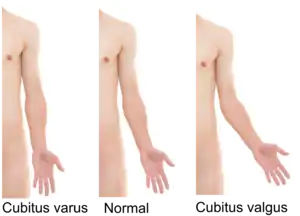Cubitus valgus
Cubitus valgus is a medical deformity in which the forearm is angled away from the body to a greater degree than normal when fully extended. A small degree of cubitus valgus (known as the carrying angle) is acceptable and occurs in the general population.
| Cubitus valgus | |
|---|---|
 | |
| Cubitus varus versus cubitus valgus | |
| Specialty | Medical genetics |
When present at birth, it can be an indication of Turner syndrome[1] or Noonan syndrome. It can also be acquired through fracture or other trauma. The physiological cubitus valgus varies from 3° to 29°. Women usually have a more pronounced Cubitus valgus than men. The deformity can also occur as a complication of fracture of the lateral condyle of the humerus, which may lead to tardy/delayed ulnar nerve palsy. The opposite condition is cubitus varus (736.02).
See also
References
- Chapter on Amenorrhea in: Bradshaw, Karen D.; Schorge, John O.; Schaffer, Joseph; Lisa M. Halvorson; Hoffman, Barbara G. (2008). Williams' Gynecology. McGraw-Hill Professional. ISBN 978-0-07-147257-9.
This article is issued from Wikipedia. The text is licensed under Creative Commons - Attribution - Sharealike. Additional terms may apply for the media files.